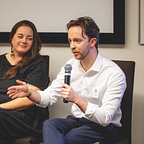Using old tools to create new systems
In 2019, Time’s Person of the Year Greta Thunberg caught criticism for a lot of her beliefs and actions. The most ridiculous of which may well be those claiming hypocrisy for the amount of plastic seen in this tweet.
Ignoring the fact that Greta spent 15 days at sea to get to the UN Climate Summit in New York without contributing any more than needed to her carbon footprint, the argument that you can’t be a true climate activist if you use plastics is crazy — but it does highlight a topic that’s worth exploring: The need to use old tools to create new systems.
This is the very basis of technology and innovation. When we had rocks, we made sharper rocks. When we had sharper rocks, we made wheels — and on and on until today — When we’ve turned those rocks into super computers, satellites, and skyscrapers.
But Edison invented the lightbulb under the glow of a candle, the Wright brothers got to Kill Devil Hills by wagon, and the Apollo missions were made possible with computers a million times less powerful than the phone in your pocket or hand right now.
Climate change cannot be solved with the tools of tomorrow. They will never come. We only have what we have today — and what we have today are the tools that got us into this mess in the first place.
This isn’t necessarily a problem — it’s more just the way the world is. Calling it a problem is the same as calling a rain storm a problem, or an avalanche. It’s how the world operates — the only problem is in how we perceive it.
I look at it almost as bootstrapping on a massive scale. Bootstrapping — in the startup world — is growing your company with only the revenue earned by your company. You don’t take any outside investment. you use the tools you have on hand to gain an advantage, then you leverage that advantage to gain another — and on and on until you reach your goal. Starting to sound familiar?
One man that’s put this concept into action is Kyle McDonald. Over the course of 14 trades, Kyle went from a simple red paperclip to a house — echoing the parable of the straw millionaire. In 2005, Kyle traded his single red paperclip for a fish-shaped pen. That fish shaped pen was swapped for a hand-sculpted doorknob — and on and on until he owned a house in Saskatchewan.
Regardless of the form it takes, using our current resources to create the tools of tomorrow is the way it’s always been done — because it’s the only way to do it. Innovation is the process of going from now to tomorrow — not tomorrow to tomorrow.
Whether it’s solving climate change, inventing the lightbulb, or some innovation we can’t even fathom yet — it has been done, and will always be done, with the tools we have on hand in the present moment.
So the question now is — what’s our red paperclip?
